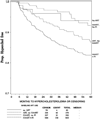Association of hypercholesterolemia incidence with antiretroviral treatment, including protease inhibitors, among perinatally HIV-infected children
- PMID: 18209684
- PMCID: PMC3089963
- DOI: 10.1097/QAI.0b013e3181648e16
Association of hypercholesterolemia incidence with antiretroviral treatment, including protease inhibitors, among perinatally HIV-infected children
Abstract
Context: Antiretroviral therapy has been associated with hypercholesterolemia in HIV-infected children. Few longitudinal studies have been conducted to examine this association, however.
Objective: To evaluate the incidence of and risk factors for development of hypercholesterolemia in a large pediatric study.
Design: Prospective cohort study (Pediatric AIDS Clinical Trials Group 219C).
Participants: A total of 2122 perinatally HIV-infected children free of hypercholesterolemia at entry.
Outcome: Development of hypercholesterolemia (total cholesterol >or=220 mg/dL at 2 consecutive visits). Cox proportional hazards models were used to evaluate risk factors.
Results: Thirteen percent of children had hypercholesterolemia at entry, and an additional 13% developed hypercholesterolemia during follow-up for an incidence rate of 3.4 cases per 100 person-years (95% confidence interval [CI]: 3.0 to 3.9). After adjustment for age, boosted protease inhibitor (PI) use (hazard ratio [HR] = 13.9, 95% CI: 6.73 to 28.6), nonboosted PI use (HR = 8.65, 95% CI: 4.19 to 17.9), and nonnucleoside reverse transcriptase inhibitor use (HR = 1.33, 95% CI: 1.04 to 1.71) were associated with increased risk of hypercholesterolemia, and higher viral load was protective (>50,000 vs. <or=400 copies/mL; HR = 0.59, 95% CI: 0.39 to 0.90). Self-reported adherent subjects had higher risk.
Conclusions: PIs were significant risk factors for hypercholesterolemia. Higher viral load was protective and may reflect nonadherence. Further follow-up is critical to evaluate long-term consequences of chronic PI exposure and hypercholesterolemia.
Figures
References
-
- Gortmaker S, Hughes M, Cervia J, et al. for the Pediatric AIDS Clinical Trials Group Protocol 219 Team. Effect of combination therapy including protease inhibitors on mortality among children and adolescents infected with HIV-1. N Engl J Med. 2001;345:1522–1528. - PubMed
-
- Gona P, Van Dyke R, Williams P, et al. Incidence of opportunistic and other infections in HIV-infected children in the HAARTera. JAMA. 2006;296:292–300. - PubMed
-
- Storm D, Boland M, Gortmaker S, et al. for the Pediatric AIDS Clinical Trials Group Protocol 219 Study Team. Protease inhibitor combination therapy, severity of illness, and quality of life among children with perinatally acquired HIV-1 infection. Pediatrics. 2005;115:e173–e182. - PubMed
-
- Lee G, Gortmaker S, McIntosh K, et al. for the Pediatric AIDS Clinical Trials Group Protocol 219C Team. Quality of life for children and adolescents: impact of HIV infection and antiretroviral treatment. Pediatrics. 2006;117:273–283. - PubMed
-
- Buchacz K, Rogol A, Lindsey J, et al. for the Pediatric AIDS Clinical Trials Group 219 Study Team. Delayed onset of pubertal development in children and adolescents with perinatally acquired HIV infection. J Acquir Immune Defic Syndr. 2003;33:56–65. - PubMed
Publication types
MeSH terms
Substances
Grants and funding
LinkOut - more resources
Full Text Sources
Medical
Research Materials
Miscellaneous


